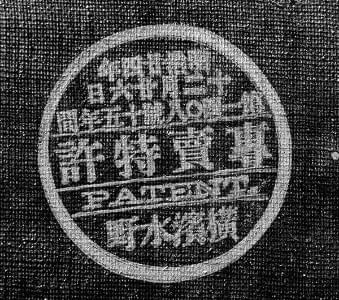
WHAT I LEARNT ABOUT MIZUNO AND HIS PROCESS
In spite of it being hailed as Japan’s greatest contribution to photography in 1891, and receiving great accolades at exhibitions and commercial success, very little scholarship exists on this process or the photographer and inventor. Collecting institutions in general have considered Mizuno’s process as a decorative one, rather than as original photographic expression. It has thus been largely overlooked by art historians and this is reflected in the scant literature available.
Collectors and conservators on the other hand, are responsible for the bulk of knowledge we have on this process. It is when we see Mizuno’s metallic photographs as objects that their true uniqueness is revealed. The mizunotype's various parts link up to the greater story of photography. When we look at their materiality, we can see how his experimentations reflect the spirit of the age in the rapidly industrializing Japan of the 1890s. In fact, Mizuno’s photographs participated in the World Fairs in Chicago in 1893, Paris in 1900 and in St. Louis in 1904, where according to the evidence, they received prestigious recognition.
Mizuno successfully fused together the most sophisticated imaging technology of his day with the ancient art of maki-e. While other photographers around the world also experimented with dust-on gold photographs, Mizuno’s process would be forever linked with the golden age of Yokohama Shashin. In the West, the cheaper, faster and easier to produce gold photographs and orotones gained ground from about 1900, Edward S. Curtis being perhaps its most well known exponent. Mizuno’s process disappeared from the photography market sometime after the demise of the Japanese souvenir album in the first decade of the twentieth century. It is a complex, time consuming, specialized and expensive process which, however, would be preserved by his descendants in other applications well into the 1960s. As Mizuno stated in his patent, the process could work with any image that could be photographed with a glass plate negative.
The mizunotype's roots in maki-e lacquer cannot be stressed sufficiently. It is a true synthesis between Japanese and Western image making traditions and the complexity of both systems are combined in such a way as to create something greater than the sum of its parts, for one cannot exist without the other in this expression. I have the impression that one must be both a photographer and a lacquer artist in order to make a mizunotype.
It is wonderful then, that The Royal Ontario Museum posses not only an example of a rare silver mizunotype, but one made of a Kozaburo Tamamura image on the cover of one of his top-tier composite albums. While uncredited, the works by some of Yokohama’s most prestigious photographers, lacquer makers and illustrators are prominently featured in this object. It is a time capsule, and a sort of microcosm example of the state of photography and the market, the finesse of Japanese tourist photographs in the closing years of the Meiji Era. It is thus an object worthy of further specialized study.
Celio H. Barreto is an emerging Asian Art Collections Manager, Photographic Preservation Specialist, Photohistorian, Independent Curator of Photography, Photographica Collector, MultiMedia Art Maker, Avid Instagrammer, Deltiology enthusiast, and a member of the Photographic Historical Society of Canada. Barreto's FPPCM MA Thesis is titled Unfolding Margaret MacLean's Orihon-format Scrapbook in the Royal Ontario Museum Collection: a Focus on Context, Preservation and Access. He is co-founder and co-director of SoHo Art Gallery in Osaka, Japan (2007 - present). He lives in Toronto, Canada with his family.
Bibliography
Bennett, Terry. Photography in Japan 1853-1912,
Tuttle, London, 2006
———. Old Japanese Photographs: Collectors’ Data Guide,
London, 2006
Brinkley, Francis. Japan: Described and Illustrated by the Japanese: written by eminent Japanese authorities and scholars, JB Millet, Boston. 1897.
Dobson, Sebastian, Nakamura Morse, Anne, Sharf, Frederic A. Art and Artifice: Japanese Photographs of the Meiji Era.
MFA Boston, 2004
Dower, John W. "Yokohama Boomtown." Visualising Cultures, 2008. http://visualizingcultures.mit.edu
Gartlan, Luke. A Career of Japan: Baron Raimund von Stillfried and Early Yokohama Photography, Leiden and Boston: Brill, 2016.
The Directory and Chronicle for China, Japan, Corea, Indo-China, Straits Settlements, Malay States, Siam, Netherlands India, Borneo, The Philippines, &c.: With which are incorporated “The China Directory” and “The Hong Kong Directory and Hong List for the Far East” for the year 1905, Hong Kong Daily Press, London, 1905.
Hight, Eleanor M.. Capturing Japan In Nineteenth-Century New England Photography Collections.
Ashgate, London, 2011.
Japan Photographers Association. A Century of Japanese Photography.
Pantheon Books, New York, 1980.
———. "Felice Beato's Japan: Places." http://ocw.mit.edu/ans7870/21f/21f.027/beato_places/fb1_visnav01.html
———. "Felice Beato's Japan: People." http://ocw.mit.edu/ans7870/21f/21f.027/beato_people/fb2_visnav01.html.
Ogawa Kazumasa. Some Japanese Flowers: Chromo-Collotypes,
Kelly & Walsh, Tokyo. [189?]
Li, Jenny and Joint Graduate Program in Photographic Preservation and Collections Management. "Two 19th Century Japanese Souvenir Travel Albums at the Art Gallery of Ontario: Jenny Li." Ryerson University, Toronto. 2009.
Marriage, John. Mabuchi Isamu and Ware, Mike. ‘The Gold Photographs of Mizuno Hanbeh’, Photographica World, No. 122, April 2007, pp 19 -38.
Nishimura Morse, Anne, Rimer, J Thomas, Brown, Kendall H. Art of the Japanese Postcard : the Leonard A. Lauder Collection at the Museum of Fine Arts, Boston,
MFA, Boston, 2004.
Reilly, James M. Care and Identification of 19th-Century Photographic Prints,
Image Preservation Institute, New York. 1986.
Simon, Anabelle. “Nineteenth Century Japanese Photography:
Techniques, Conservation and Restoration”. Association France Japon-Nord / Japan Society Symposium Les Collections d'Art Japonais en Europe, October 1997.
Library of Congress, “Thesaurus for Graphic Materials”
https://www.loc.gov/pictures/collection/tgm/
Wakita, Mio. 2009. “Selling Japan: Kusakabe Kimber's Image of Japanese Women”. History of
Photography 33 (2) Page 209 to 223
———. 2013. “Sites of "Disconnectedness": The Port City of Yokohama, Souvenir Photography,
and its Audience”. Transcultural Studies 2 (2013)
Winkel, Margarita. Souvenirs from Japan: Japanese Photography at the Turn of the Century.
Antique Collector’s Club, Massachusetts, 1991.
Worswick, Clark. Japan: Photographs 1854–1905.
New York: Pennick Publishing, 1979.